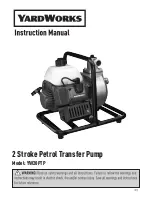
13
TESTING
NOTE:
Installation MUST be complete prior to testing.
System MUST be tested prior to operation.
LEAKAGE TEST
Use standard A/C practices to properly check refrigeration tubes and connections for any leaks
prior to system start up.
AIR PURGING AND PRESSURE TEST
Remove bonnet (cover) of gas valve on outdoor unit.
Charge system with Nitrogen to 100 PSI and check for leaks.
Evacuate Nitrogen.
Connect the gas valves of a vacuum gauge, vacuum pump, and
outdoor unit(see diagram). Start the vacuum pump and allow to run
for at least 30 minutes at a level of 500 microns or less.
Shut off the vacuum and continue to monitor vacuum gauge for
another 15 minutes. The pressure should not rise above 800 microns.
lf a vacuum of 500 microns cannot be obtained, or if it rises above
800 microns during the l5-minute monitoring period, pressurize the
system with nitrogen and look for leaks. Repair any leaks that are
found and repeat the vacuum testing.
Close the valves to the vacuum pump and gauge and disconnect
from the outdoor unit.
Tighten bonnet (cover) of gas valve and open gas and liquid valves
completely.
SYSTEM TESTING
Before testing the system, ensure that cut-off valves of the
connection pipes are opened and that all debris (such as packing
scraps, debris, etc.) are clear from the unit.
Switch on power to the system and press the ''ON/OFF'' button on the
remote control to activate the indoor unit.
Press ''MODE'' button repeatedly, taking a moment on each setting to
ensure that system functions in all modes.
If the remote control is lost, emergency run operation can be initiated
by pressing the button in the upper right corner of the indoor unit
under the cover panel. (see diagram)





































